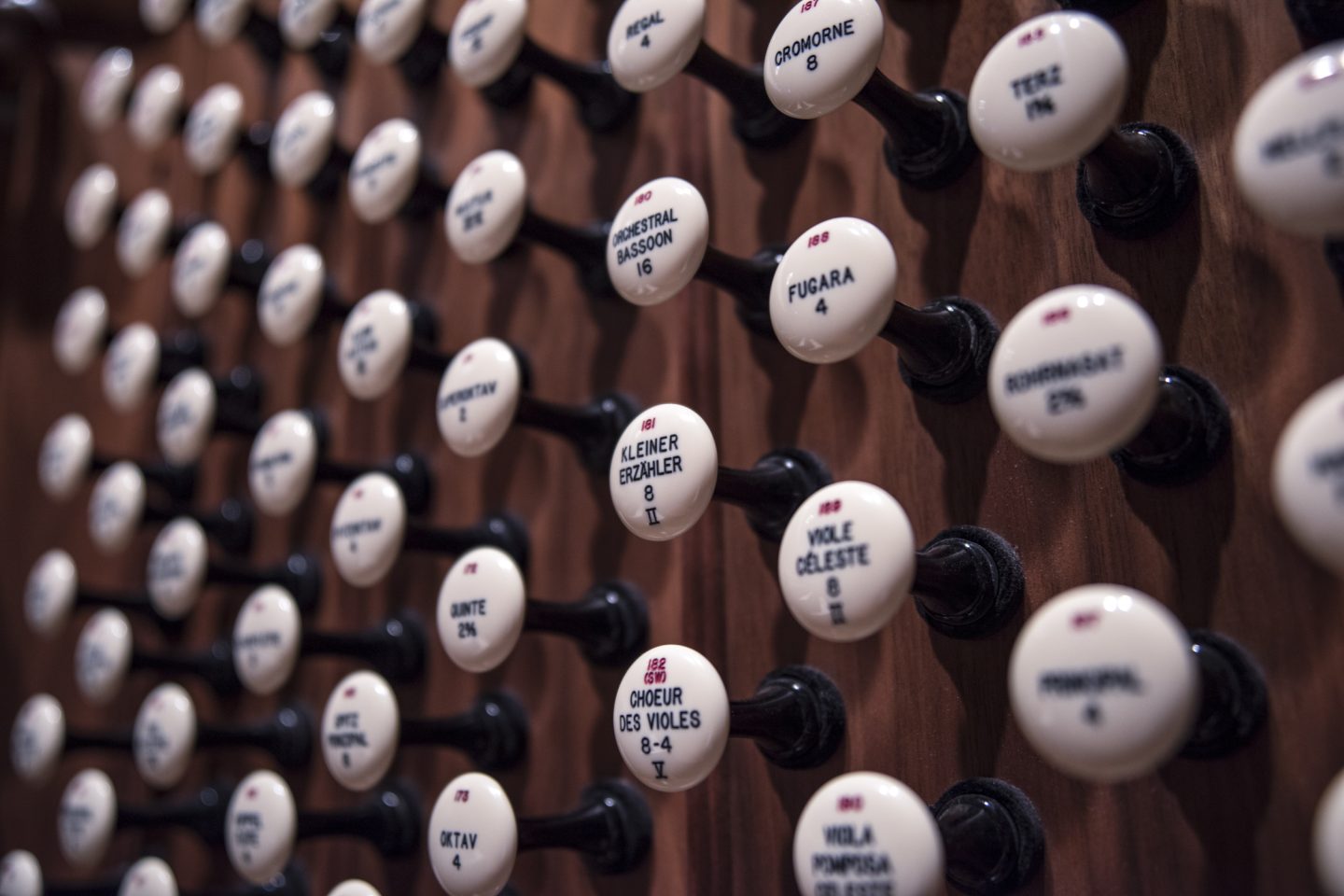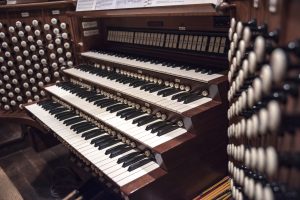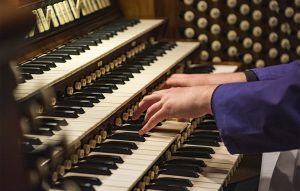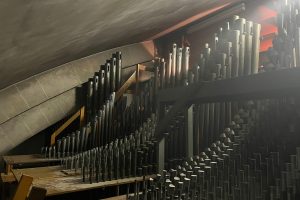
Organ 101
In many ways, a pipe organ is a one-person band. It’s like all the instruments on a concert stage squeezed into one mighty instrument, all at once.
An organ can summon a clarinet, a string section, an oboe, a fleet of trumpets or even the human voice (or something close to it). One key can mimic one flute, or several hundred flutes. Just one of the keyboards can pull together an entire orchestra.
Put it all together and you have the signature sound of the organ, adaptable for everything from congregational singing to solo recitals to epic film scores. The Cathedral organ’s 10,647 pipes produce 10,647 unique voices – not exactly efficient, but imminently versatile.
Organ Mechanics
Though an organ is an incredibly complex machine, the mechanics of how an organ works are fairly straightforward.
interconnected ‘whistles’
Think of an organ as a series of interconnected whistles of varying shapes and sizes. Some are big, some are tiny and delicate. Some are round, some are square. Most are metal, but some are wood. Most are vertical, but the really big ones are horizontal. Each has a hole where compressed air escapes at just the right moment.
circulating air
It starts with air that is generated by a blower. An organ, like a fire, needs air to come alive. The air is circulated throughout the organ, ready to escape when the organist decides it’s time.
keys and pedals
A series of chambers, or reservoirs, acts like a pair of lungs, expanding and contracting to provide air that allows the instrument to breathe. And, like the human body, the organ “speaks” when that air is released.
When a key or foot pedal is pressed on the console, it triggers an electrical current that signals the valve on a particular pipe to open and release the air. The air flowing through the pipe makes the sound of that note. All of it is supported by a computerized circuit board that processes commands in milliseconds.
putting it together
Combining musical know-how and a conductor’s sense of sound and texture, the organist can pull together different combinations of pipes, known as stops and divisions, to create different layers of sound. The recipe of pipes can result in something soft and delicate, or strong and mighty. Playing the organ requires the organist to combine near acrobatics with their hands and coordinated footwork on the pedals.
Organ Terminology
You’ll notice more than 150 stops, or knobs, on either side of the organ console. Each stop controls a series of 61 pipes that all make the same tone. Think of them like members of an orchestra: when the organist pulls a stop, all the pipes in that group work together to mimic the sound of a certain instrument, such as a flute or violin.
 Ever heard of the phrase “pulling out all the stops”? That comes from the organ, when you quite literally pull out all the stops to harness the full power and potential of the instrument.
Ever heard of the phrase “pulling out all the stops”? That comes from the organ, when you quite literally pull out all the stops to harness the full power and potential of the instrument.
A division is a group of stops, all connected together. Think of it like a nesting doll: different sets of pipes comprise a stop; different sets of stops comprise a division; and different divisions work together to comprise the organ.
A swell is a type of division, and it gets its name from its ability to make the music, well, swell. It’s typically used for quieter music or to accompany singers. The organist can manipulate wooden shutters, called shades, that open and close to adjust the volume of the swell division.
The Great division, meanwhile, is the source of the organ’s real power. These stops produce the organ’s mighty and majestic sounds; there are no shades used here, which allows the strongest sounds to really travel.
A Chorus is a group of stops that are meant to be used together. Like members of a choir, they are typically positioned close to each other to help reinforce each “voice” and produce a collective sound. The sound from one chorus complements the sound produced by a different chorus.
 A manual is another name for the keyboard, comprised of 61 black and white keys. The Cathedral organ has four stacked manuals, for a total of 244 keys. The manuals (think mani-cure) are played with the organist’s hands, and each keyboard controls a different piece, or division, of the organ. The organist can switch from one manual to another to summon different sounds, using different parts of the organ, within the same piece of music.
A manual is another name for the keyboard, comprised of 61 black and white keys. The Cathedral organ has four stacked manuals, for a total of 244 keys. The manuals (think mani-cure) are played with the organist’s hands, and each keyboard controls a different piece, or division, of the organ. The organist can switch from one manual to another to summon different sounds, using different parts of the organ, within the same piece of music.
The pedal board (think pedi-cure) is the keyboard that is played with the organist’s feet. There are fewer pedals (32), which is good because it means less fancy footwork for the organist. The pedals produce the lowest bass notes in the organ.
 Small buttons along the keyboards called Pistons allow the organist to pre-program combinations of stops and divisions to produce desired sounds. Instead of juggling all those stops while trying to play, the organist can pre-program their choices during rehearsal and then simply push a piston button, causing the sound of the organ to shift to what they want, when they want it.
Small buttons along the keyboards called Pistons allow the organist to pre-program combinations of stops and divisions to produce desired sounds. Instead of juggling all those stops while trying to play, the organist can pre-program their choices during rehearsal and then simply push a piston button, causing the sound of the organ to shift to what they want, when they want it.
A chamade is a horizontal pipe that projects out into the audience to produce a loud trumpet sound, like a fanfare. These are some of the loudest and most aggressive pipes in the organ, and you can’t miss their distinct call to attention.
The pipes – all 10,647 of them – work like a series of interconnected whistles. Air is blown into each pipe and released through a small opening. A flute pipe makes a sound by forcing air though a narrow opening; a reed pipe makes a different sound by the air vibrating against a reed (like a clarinet or saxophone, but metal) as it makes its escape from the pipe.

The unique sound produced by each pipe is determined by its shape, length and width. Each pipe produces exactly one note, with one kind of sound. The smallest pipe is about the size of a pencil; the largest pipe is 32 feet long, large enough for an adult to crawl inside and lay down comfortably.
The longer the pipe, the lower the sound. Shorter pipes deliver higher notes. An 8-foot pipe, for example, may be tuned to a low C. A 4-foot pipe of the same shape also plays C, but one octave higher (Middle C), and 2-foot pipe plays C an octave higher than that.
 A rank is a collection of pipes, one for each key on the keyboard. The Cathedral organ has 189 ranks, each with their own unique high or low pitch. When you multiply the number of pipes in each rank by the number of ranks, you get to the total number of pipes: 10,647.
A rank is a collection of pipes, one for each key on the keyboard. The Cathedral organ has 189 ranks, each with their own unique high or low pitch. When you multiply the number of pipes in each rank by the number of ranks, you get to the total number of pipes: 10,647.
The organ is powered by two massive blowers, which pump air into the organ from the basement crypt. Smaller supplemental blowers are placed throughout the instrument to provide high pressure where needed.
The organ’s reservoirs are like the lungs of the organ; they expand and contract (like an accordion) to keep the air pressure regulated and stable. When the reservoirs crack or start leaking, the organ makes a wheezing sound as the air escapes to places it’s not meant to go.
A windchest is one of the most important parts of the organ. The pipes rest snuggly on holes in the windchest, which is essentially a large box filled with compressed air that is ready to escape. Inside the windchest, an intricate series of valves open and close to release or restrict air into the pipes, all determined by which keys, pedals and stops the organist is using at that moment.